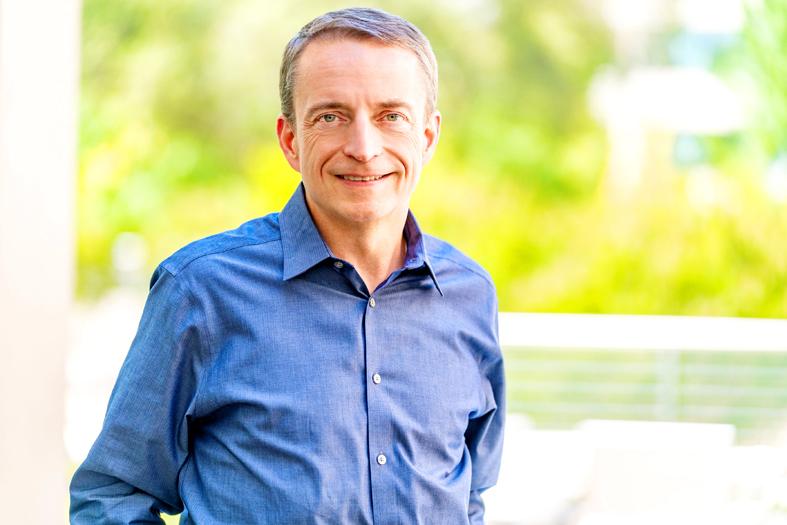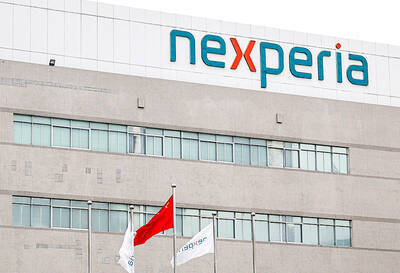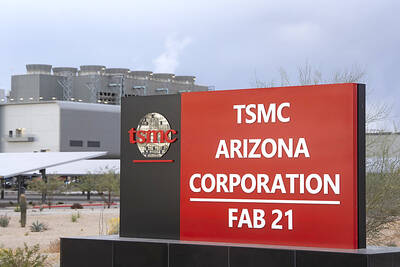Intel Corp is replacing its chief executive officer after only two years in what had been a rough stretch for the chipmaker.
Bob Swan, who became the company’s CEO in early 2019, is in the middle of next month to be replaced by industry veteran Pat Gelsinger, the company said.
The choice of Gelsinger, who decades ago started his career as an Intel engineer, puts the semiconductor pioneer back in the hands of a tech expert at a time when it is struggling to keep up with market changes and growing competition.

Photo: Reuters
On Wednesday, Intel’s stock jumped 7 percent on news of the change at the top.
The California-based company said that the change in leadership is unrelated to its financial performance last year, but the surprise shake-up followed several weeks of investor activism by hedge fund Third Point LLC, which had pushed for big changes.
Intel late last month acknowledged that it had received a letter from the New York-based fund and was working with it on ideas “regarding enhanced shareholder value.”
Third Point CEO Daniel Loeb on Wednesday wrote on Twitter that “Swan is a class act and did the right thing for all stakeholders stepping aside for Gelsinger.”
Intel spokesman William Moss said that the leadership change “was not driven by Third Point.”
Intel chairman Omar Ishrak said in a prepared statement that “the board concluded that now is the right time to make this leadership change to draw on Pat’s technology and engineering expertise during this critical period of transformation at Intel.”
the chipmaker last year disclosed that there would be a substantial delay in its development of a next-generation process already in use by other major suppliers, including Taiwan Semiconductor Manufacturing Co (台積電).
The unexpected snag meant that Intel’s 7-nanometer processing technology is unlikely to be ready until the end of next year or early 2023, potentially putting the company behind its rivals.
Apple Inc last year also dealt a blow to Intel when it began replacing Intel processors with Apple-designed chips in its new computers.
Intel faced yet another challenge when US graphics chipmaker Nvidia Corp announced plans to buy UK-based Arm Ltd in a deal that would create a global powerhouse in the industry.
Gelsinger has since 2012 been CEO of software company VMware Inc and has more than four decades of experience in the industry. He spent most of that time with Intel, where he began his career and was its first chief technology officer.
Swan, a former chief financial officer at Intel, assumed interim leadership in 2018. His finance background, including top finance roles at eBay Inc and several other firms, marked a shift for Intel, which has mostly had engineers at the top since its 1968 founding, although its fifth CEO was an economist.
Swan said in a prepared statement that it is the right time for a transition and that he fully supports Gelsinger’s arrival.

JITTERS: Nexperia has a 20 percent market share for chips powering simpler features such as window controls, and changing supply chains could take years European carmakers are looking into ways to scratch components made with parts from China, spooked by deepening geopolitical spats playing out through chipmaker Nexperia BV and Beijing’s export controls on rare earths. To protect operations from trade ructions, several automakers are pushing major suppliers to find permanent alternatives to Chinese semiconductors, people familiar with the matter said. The industry is considering broader changes to its supply chain to adapt to shifting geopolitics, Europe’s main suppliers lobby CLEPA head Matthias Zink said. “We had some indications already — questions like: ‘How can you supply me without this dependency on China?’” Zink, who also

The number of Taiwanese working in the US rose to a record high of 137,000 last year, driven largely by Taiwan Semiconductor Manufacturing Co’s (TSMC, 台積電) rapid overseas expansion, according to government data released yesterday. A total of 666,000 Taiwanese nationals were employed abroad last year, an increase of 45,000 from 2023 and the highest level since the COVID-19 pandemic, data from the Directorate-General of Budget, Accounting and Statistics (DGBAS) showed. Overseas employment had steadily increased between 2009 and 2019, peaking at 739,000, before plunging to 319,000 in 2021 amid US-China trade tensions, global supply chain shifts, reshoring by Taiwanese companies and

Taiwan Semiconductor Manufacturing Co (TSMC, 台積電) received about NT$147 billion (US$4.71 billion) in subsidies from the US, Japanese, German and Chinese governments over the past two years for its global expansion. Financial data compiled by the world’s largest contract chipmaker showed the company secured NT$4.77 billion in subsidies from the governments in the third quarter, bringing the total for the first three quarters of the year to about NT$71.9 billion. Along with the NT$75.16 billion in financial aid TSMC received last year, the chipmaker obtained NT$147 billion in subsidies in almost two years, the data showed. The subsidies received by its subsidiaries —

OUTLOOK: Pat Gelsinger said he did not expect the heavy AI infrastructure investments by the major cloud service providers to cause an AI bubble to burst soon Building a resilient energy supply chain is crucial for Taiwan to develop artificial intelligence (AI) technology and grow its economy, former Intel Corp chief executive officer Pat Gelsinger said yesterday. Gelsinger, now a general partner at the US venture capital firm Playground Global LLC, was asked at a news conference in Taipei about his views on Taiwan’s hardware development and growing concern over an AI bubble. “Today, the greatest issue in Taiwan isn’t even in the software or in architecture. It is energy,” Gelsinger said. “You are not in the position to have a resilient energy supply chain, and that,